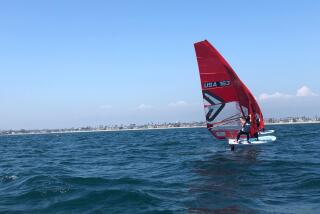CARDBOARD BOAT RACING : Sink and Swim : At Thomas Aquinas College in Santa Paula, contestants try to sail in a contest that’s all wet.
- Share via
As surely as basketball reigns at UCLA and the glory of rowing provides inspiration at Harvard, the spirit of competition thrives at Thomas Aquinas College. It is in the running of the arduous Cardboard Boat Race.
Unsung in intercollegiate sports--in fact, unparticipatory--the tiny Santa Paula school (enrollment 175) proved last weekend that a buoyant spirit can overcome engineering that is, for the most part, all wet.
The sixth-annual race highlighted the school’s Alumni Day activities, when several hundred fans crowded the shore of a stream-fed lagoon on campus to watch participants slather their crafts’ hulls with baking grease, the only waterproofing allowed.
The one and two-person boats, constructed entirely of grocery cartons and tape, boasted such features as sculptured prows, keels and elaborate oars--also fashioned of cardboard, with only enough tape to secure their separate parts.
Crew attire for the 50-yard run ranged from jerseys and cutoffs to suit coats and ties--the latter worn by those with confidence in their design skills. As all students at the school are liberal arts majors, they all were, mechanically speaking, in the same boat.
At the cry of “Lower your boats!” half of the field of 13 entries hit the water for the first time, their vessels being too frail for test runs.
Cheers went up as teams climbed aboard--and half of the fleet immediately took on water and sank, leaving the rest to maneuver past flailing crews.
The crowd went wild as the self-powered crafts plunged through the waves at speeds up to a knot and a half. All three made shore--but the disintegrating hulks of vessels and major steering problems had cost them precious time. It remained for the second heat to produce the winner.
Tension mounted during a delay to clear the flotsam from the water. Then the remaining heat was under way.
A flat-bottomed dingy piloted by senior Angie Murray and sophomore Alicia Lawless unexpectedly pulled ahead of sleeker crafts and lunged to the finish in a wake of bare-handed paddling--a technique the women chose to prevent lost oars. All equipment launched must cross the finish line with the boat, a rule that results in most entrants being disqualified.
Overwhelmed by the success of their first race, Murray said, “We never dreamed it would go five feet!”
The craft favored to win, a vessel painted silver and captained by senior John Van Hecke, keeled over near the starting line and was found to track better minus Andrew Wryesinsh, its crew. The pilot, credited with inventing the grease caulking technique on a winning entry two years ago, not only finished the course, but kept afloat for a total of three laps. But because of the abandonment of crew, his run was disqualified.
Rules of the race have been hammered out over its six-year history. Each year, students come up with new innovations and, having been steeped in the school’s Socratic tradition, tend to argue the merits of their creations rather well, said student activity director Katie Ayre.
The winning time for this year’s race was clocked at one minute--but officials were uncertain if it established a record. They were clear about it having surpassed last year’s showing. In that unlucky contest, the entire field was disqualified.


